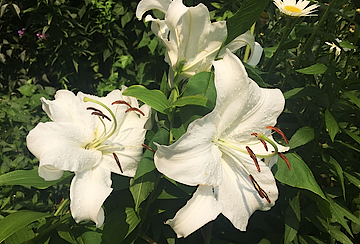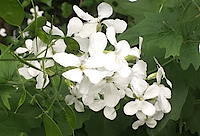
Soil Types

Garden soil is typically loam, a combination of humus, clay, sand, and silt, with good moisture retention and fertility.
If you take a handful of loamy soil and squeeze it, it will retain its loose clod structure.
Loamy soils smell like mushrooms, because they are rich in humus, and make a good home for earthworms and beneficial microorganisms.
Clay soils are very fertile, but too heavy and compact to let the water through. Their color is yellow and their appearance alternates between mud puddle and hard cement. Amending clay soil is challenging because its heavy particles stratify, leaving the added mix to wash away during the next rain.
Sandy soils comprise larger ground stone particles; they are very poor, prone to salinization, and have rapid drainage. While coastal vegetation and desert plants have evolved to withstand these conditions, the majority of plants struggle to thrive in them.
Silty soils are found in the dried-up beds of rivers and streams. While they are more fertile than sand, their loose composition makes it hard for plant roots to establish themselves. Silty soils are prone to runoff.
What is the ideal agricultural soil?
That would be the black soil, the chernozem.
Black soil is rich in humus, phosphorus, and ammonia, and produces very high yields due to its fertility and moisture retention ability.
Its dark, rich and buttery medium is a precious resource that can only be found in a few places on Earth, primarily in the temperate grasslands.

Sun Exposure

To be considered full sun exposure, an area needs to receive a minimum of six hours of direct sunlight daily, whereas full shade means less than two hours of it.
Dappled shade is the shade under deciduous trees, where the wind constantly moves the foliage to let the sun rays through. The area receives abundant sunlight during early spring, making it perfect for a bulb garden.
Light shade happens in a place open to the sky, but which the sun cannot reach. A north foundation planting is a perfect example. It is suitable for shade tolerant plants broadly classified as part shade, including bleeding hearts, lily of the valley, delphiniums, and asters.
Speaking of part shade, that means between four and six hours of direct sunlight a day, usually a site that's in full sun in the morning or afternoon. Columbines, clematis, irises, coral bells, and veronicas will do well here.
Woodland shade happens in evergreen forests. This location gets a consistent level of low sun exposure, and has acidic soil which maintains its moisture, perfect for rhododendrons, azaleas, astilbes, and ferns.
Full shade means two to three hours of sun exposure per day. Most plants labeled for shade, like hostas, begonias, impatiens, and hellebores, won't bloom if they don't get any sun at all.
Deep shade receives no direct sunlight at all. Few plants that thrive in deep shade are able to bloom, and when they do, it is usually only for a short period in spring.
Dry shade, the most challenging growing condition, is not suitable for most plants and is best left for robust ground covers like ivies or vincas.
